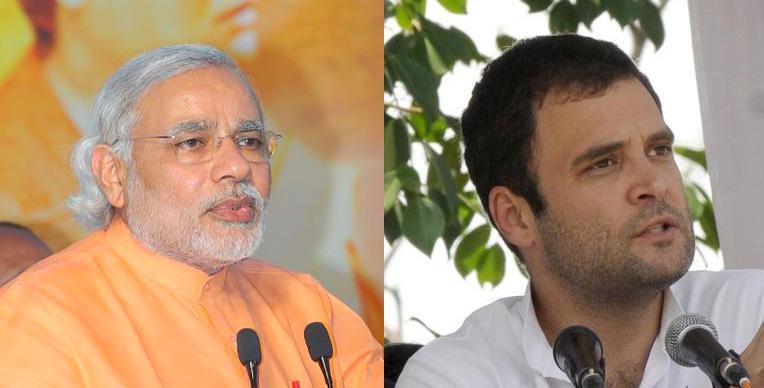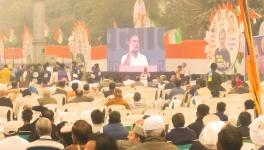Like Congress, BJP Too Faced Era of Disarray Between 2004 and 2014

To understand the predicament of any party out of power in India one must objectively study the turmoil within the Bharatiya Janata Party (BJP) between 2004 and 2014 when once hardline champion of Hindutva and former Uttar Pradesh chief minister Kalyan Singh deserted Sangh Parivar and virtually bowed before none else but the arch rival Mulayam Singh Yadav.
Similarly, his Madhya Pradesh counterpart, Uma Bharati, bid goodbye to the saffron camp and floated her own Bharatiya Janshakti Party. Another ex-CM, Karnataka’s B S Yediyurappa, rebelled against the party leadership to float his own outfit in 2012.
Not to forget, the party’s patriarch Lal Krishna Advani had to publicly face humiliation and insult at the hands of his own foot-soldiers after his secular remarks on Pakistan’s founder Mohammad Ali Jinnah in his birthplace Karachi in June 2005. Four years later, in
August 2009, the BJP had to expel the party’s third most influential face, Jaswant Singh, when he, in his book, blamed Jawaharlal Nehru and not Jinnah for the partition of the Indian sub-continent.
Politics of Powerlessness
Those journalists and columnists who are ridiculing the present state of uncertainty in the Indian National Congress must first understand the politics of powerlessness. If Kalyan Singh, once ousted from power, had to join hands with ‘Maulana’ Mulayam Singh Yadav, whom he would accuse of ‘bloodbath’ of Kar Sevaks in police firings in Ayodhya on October 30
and November 2, 1990, when the latter was the chief minister of UP, then what is happening in Congress in Himachal Pradesh, Maharashtra or elsewhere is not something out of world.
Needless to say, Uma Bharti, the heroine of the demolition of Babri Masjid on December 6, 1992, blamed her own party top brass when she was replaced with lesser known Babulal Gaur on August 23, 2004, that is just 100 days after the Atal Bihari Vajpayee government was voted out of power on May 13.
In the laboratory of Hindutva (in Gujarat), two prominent faces with RSS (Rashtriya Swayamsevak Sangh) background, Keshubhai Patel and Shankarsinh Vaghela too had ditch the saffron party. While Vaghela left it earlier, in late 1990s, Patel, considered as a mentor of Prime Minister Narendra Modi resigned from the party in 2012 and formed his own outfit.
Former International Working President of Vishwa Hindu Parishad, Pravin Togadia, once Modi’s best friend, snapped his four-decade-long relationship with latter when he was chief minister of Gujarat. He became the bitterest critic of Modi.
Curiously, the then ruling Manmohan Singh-led United Progressive Alliance government was, unlike today, not at all responsible for the prevailing anarchy within the ‘well-disciplined’ and ‘cadre-based’ BJP, which always boasted of being a “party with difference”.
Without taking into account the unpleasant record of out of power BJP, recently a Britain-based senior journalist, in an opinion article in a premier newspaper in India,
called Rahul Gandhi’s Bharat Jodo Nyay Yatra a “farce”. Another opinion piece, this time by a sociologist, took great pain to explain the diminishing returns of Rahul’s latest Yatra.
These two gentlemen do not fall in the ‘godi media’ category. And there are several others in the secular camp who are engaged in such Rahul-bashing. What these so-called neutral political pundits tend to forget is that they had committed a similar mistake way back in 2004, when they unanimously dismissed any chance of Sonia Gandhi coming to power. Many of these ‘balancers’ used to mock Sonia’s “poor knowledge” of Hindi.
No doubt, Sonia Gandhi was no match to the oratory skill of PM Atal Bihari Vajpayee or Advani, yet she upset the BJP’s apple-cart.
Short Memory
Rahul may or may not be in the race this time, but there is little scope for going overboard in criticising all his action. At least he is going to masses, raising their problems and communicating with them. Those with short memory are questioning the timing of the latest Yatra of Rahul Gandhi, but what they forget is that the then deputy Prime Minister Advani, with his wife and daughter, launched a 33-day long 8,000 km-long Bharat Uday Yatra from Kanyakumari on March 10 when the Lok Sabha poll was to take place in April-May. That was hailed as a “great political move”.
Leading an Opposition party in a democracy like India is not an easy task, and that too when the rival is hell-bent upon using all sorts of means, fair and foul. Yet, how can
one deny the fact that Congress snatched power from the BJP in Karnataka and Himachal Pradesh and from Telangana Rashtra Samiti since Rahul’s first Yatra.
What is more amazing about the 2004 election result is that Congress had entered into alliance with regional parties only in a couple of states, for example, in Tamil Nadu and Bihar.
It is true the secular and communist parties were relatively strong then. But the BJP-led National Democratic Alliance, unlike today, had several influential regional parties as its constituents. This included Trinamool Congress in West Bengal, Biju Janata Dal in Odisha, Telugu Desam Party in Andhra Pradesh, Shiv Sena in Maharashtra, Shiromani Akali Dal in Punjab, Janata Dal (United) in Bihar, AIADMK in Tamil Nadu, National Conference in Jammu and Kashmir etc.
Not only that, the economy showed signs of improving with the growth rate touching the 8% mark. Yet the BJP-led NDA was trounced by the rag-tag army of Sonia Gandhi, against whom massive campaign of foreign origin was launched by the ruling establishment.
As if that was not enough, the Congress split on May 25, 1999 on this very issue. Three senior leaders of the party, Sharad Pawar, Tariq Anwar and P A Sangma, parted ways to form the Nationalist Congress Party. It is another thing that today the main faction of NCP, led by Pawar, is aligning with the same Congress in Maharashtra.
Thus, in 2004 Congress was at its lowest point as far as popularity is concerned, yet it made a surprise comeback.
In 2024, too, the Grand Old Party is facing the same challenge. It is in power in just a handful of states. Yet, one thing is somewhat different. Its leader, especially Rahul Gandhi, is on the streets
If the BJP suffered a shock defeat in 2004, in the 1977 election, Congress met with a similar fate. On January 19, the then Prime Minister Indira Gandhi announced parliamentary elections. She relaxed the Emergency. Though some of the Opposition leaders were still in jail, yet Congress lost to the hurriedly formed Janata Party. By March 24, India had a new Prime Minister, Morarji Desai. Hardly any political pundit predicted that this would be the outcome.
The writer is a Patna-based freelance journalist. The views are personal.
Get the latest reports & analysis with people's perspective on Protests, movements & deep analytical videos, discussions of the current affairs in your Telegram app. Subscribe to NewsClick's Telegram channel & get Real-Time updates on stories, as they get published on our website.
























